
Female macroptera
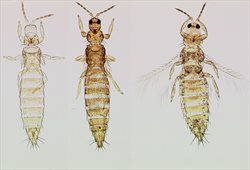
Female wing-length variants
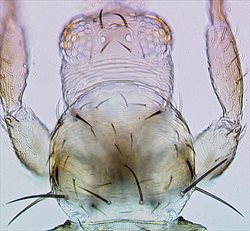
Head & pronotum

Antenna
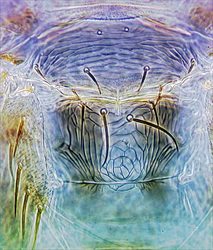
Meso & metanota
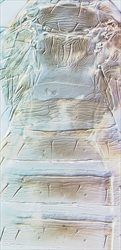
Meso & metanota and tergites I–IV
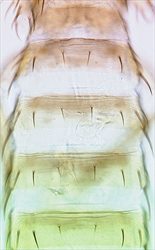
Tergites I-V

Tergites VI–VIII
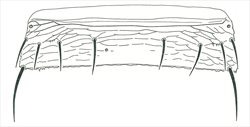
Tergite V

Fore wing
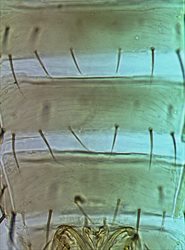
Sternites V–VII
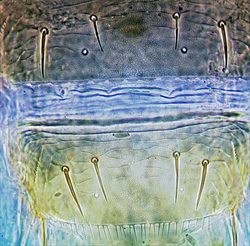
Tergites VII-VIII
Female sometimes fully winged, but more commonly both sexes with wings shorter than thorax width. Body mainly yellow, abdominal tergites shaded medially, setae dark; antennal segments III–VII dark brown, II lighter, I white; fore wing pale (when present) with dark setae. Antennae 7-segmented; segments III–IV with short forked sense cone; segment VII slender. Head with 2 pairs of ocellar setae; pair III longer than side of ocellar triangle, arising lateral to fore ocellus; postocular setae pairs I & III shorter than ocellar setae III. Pronotum with 2 pairs of long posteroangular setae; posterior margin with 3 pairs of setae; three pairs of discal setae are larger than remaining discal setae, two near anterior margin and one near lateral margins. Metanotum with irregular reticulation; median setae arising behind anterior margin; campaniform sensilla absent. Fore wing first vein with 1–3 setae on distal half; second vein with about 10 setae. Abdominal tergite II with 3 lateral marginal setae; tergites II–III with median pair of discal setae at least half as long as median length of tergite; tergites VI–VIII with paired ctenidia, on VIII posteromesad to spiracles; tergite VIII posteromarginal comb complete, microtrichia long and slender; pleurotergites without discal setae. Sternite II with 2 pairs of marginal setae, III–VII with 3 pairs, without discal setae.
Male smaller than female; sternites III–VII with transverse pore plate.
The genus Thrips is the second largest genus in the Thysanoptera, and currently includes, worldwide, over 290 species. All members of genus Thrips lack ocellar setae I on the head, and they all have ctenidia on tergite VIII posteromesad to the spiracles. Other characters, such as number of antennal segments, number of setae on the fore wing veins, and number of discal setae on the sternites are variable between species (Palmer, 1992; Nakahara, 1994; Mound & Masumoto, 2005). T. nigropilosus is unusual because many adults of both sexes have short wings and the discal setae on the tergites, even of macropterae, are particularly long.
Feeding and breeding in the flowers and on the leaves of its host plants. Recorded in Britain from species of Plantago [Plantaginaceae], but more commonly associated with various Asteraceae, including Achillea, Chrysanthemum, and Senecio.
Generally distributed, but locally common, in Britain from Kent to northern Scotland (Mound et al., 1976), it is also occasionally found in commercial glasshouses as a minor pest of ornamental flower production. This species is distributed across the northern Palaearctic to Japan (Mirab-balou et al., 2011), and has been widely introduced around the world (for example, East Africa) as a pest on various cultivated Asteraceae, including crops of Pyrethrum.
THRIPIDAE - THRIPINAE
Thrips nigropilosus Uzel
Thrips nigropilosus Uzel, 1895: 198
Thrips nigropilosa var. laevior Uzel, 1895:199
Thrips lactucae Beach, 1896: 224
Thrips nigropilosus ab. umbratus Priesner, 1920: 59
Thrips nigropilosus f. pilosissima Priesner, 1922: 92
Mirab-balou M, Tong X, Feng J & Chen X (2011) Thrips (Thysanoptera) of China. Check List 7: 720–744.
Mound LA & Masumoto M (2005) The genus Thrips (Thysanoptera, Thripidae) in Australia, New Caledonia and New Zealand. Zootaxa 1020: 1–64.
Mound LA, Morison GD, Pitkin BR & Palmer JM (1976) Thysanoptera. Handbooks for the Identification of British Insects 1 (11): 1–79.
Nakahara S (1994) The genus Thrips Linnaeus (Thysanoptera: Thripidae) of the New World. United States Department of Agriculture. Technical Bulletin 1822: 1–183.
Palmer JM (1992) Thrips (Thysanoptera) from Pakistan to the Pacific: a review. Bulletin of the British Museum (Natural History) Entomology Series 61 (1): 1–76.